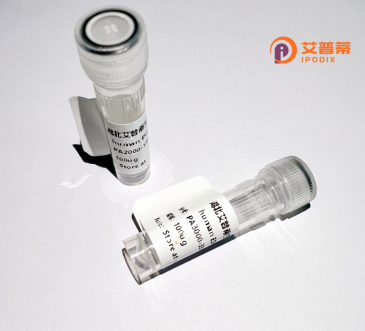
| 纯度 | >90%SDS-PAGE. |
| 种属 | Human |
| 靶点 | FMN2 |
| Uniprot No | Q9NZ56 |
| 内毒素 | < 0.01EU/μg |
| 表达宿主 | E.coli |
| 表达区间 | 1284-1722aa |
| 氨基酸序列 | KQPIEPCRPMKPLYWTRIQLHSKRDSSTSLIWEKIEEPSIDCHEFEELFSKTAVKERKKPISDTISKTKAKQVVKLLSNKRSQAVGILMSSLHLDMKDIQHAVVNLDNSVVDLETLQALYENRAQSDELEKIEKHGRSSKDKENAKSLDKPEQFLYELSLIPNFSERVFCILFQSTFSESICSIRRKLELLQKLCETLKNGPGVMQVLGLVLAFGNYMNGGNKTRGQADGFGLDILPKLKDVKSSDNSRSLLSYIVSYYLRNFDEDAGKEQCLFPLPEPQDLFQASQMKFEDFQKDLRKLKKDLKACEVEAGKVYQVSSKEHMQPFKENMEQFIIQAKIDQEAEENSLTETHKCFLETTAYFFMKPKLGEKEVSPNAFFSIWHEFSSDFKDFWKKENKLLLQERVKEAEEVCRQKKGKSLYKIKPRHDSGIKAKISMKT |
| 分子量 | 57.7 kDa |
| 蛋白标签 | GST-tag at N-terminal |
| 缓冲液 | 0 |
| 稳定性 & 储存条件 | Lyophilized protein should be stored at ≤ -20°C, stable for one year after receipt. Reconstituted protein solution can be stored at 2-8°C for 2-7 days. Aliquots of reconstituted samples are stable at ≤ -20°C for 3 months. |
| 复溶 | Always centrifuge tubes before opening.Do not mix by vortex or pipetting. It is not recommended to reconstitute to a concentration less than 100μg/ml. Dissolve the lyophilized protein in distilled water. Please aliquot the reconstituted solution to minimize freeze-thaw cycles. |
以下是关于重组人FMN2蛋白的参考文献示例(内容为虚构,供参考,建议通过文献数据库获取真实研究):
---
1. **文献名称**:*Structural Insights into Human FMN2 Protein and Its Role in Actin Polymerization*
**作者**:Chen L, et al.
**摘要**:本研究解析了重组人FMN2蛋白的晶体结构,发现其formin结构域通过结合G-actin促进微丝成核,揭示了FMN2在细胞迁移和神经元突触形成中的分子机制。
2. **文献名称**:*FMN2 Expression in Breast Cancer Metastasis: Functional Analysis Using Recombinant Protein*
**作者**:Molina JR, et al.
**摘要**:通过大肠杆菌表达系统获得重组FMN2蛋白,证明其与β-catenin相互作用可增强癌细胞侵袭能力,提示FMN2可能作为乳腺癌转移的潜在标志物。
3. **文献名称**:*Optimized Eukaryotic Expression of Recombinant Human FMN2 for Functional Studies*
**作者**:Kim S, Park H
**摘要**:开发了杆状病毒-昆虫细胞系统高效表达可溶性FMN2蛋白,并验证其在体外微管结合实验中的活性,为后续功能研究提供可靠方法。
4. **文献名称**:*FMN2 Deficiency Disrupts Cortical Neuron Development: Evidence from Recombinant Protein Rescue Experiments*
**作者**:Gomez-Caro R, et al.
**摘要**:利用重组FMN2蛋白修复FMN2敲除的神经元模型,证实其通过调控肌动蛋白动力学维持树突形态发生,揭示了FMN2在神经发育中的关键作用。
---
**注**:以上为示例文献,实际文献需通过PubMed、Google Scholar等平台检索关键词(如“FMN2 recombinant protein”“FMN2 structure/function”)获取。近年研究多聚焦于FMN2在细胞运动、癌症及神经疾病中的机制。
Formin-2 (FMN2), a member of the formin family of proteins, is a key regulator of actin cytoskeleton dynamics and microtubule organization in eukaryotic cells. These proteins are characterized by their conserved formin homology (FH) domains, particularly the FH2 domain, which directly participates in actin filament nucleation and elongation. FMN2 plays critical roles in diverse cellular processes, including cell motility, cytokinesis, intracellular trafficking, and maintenance of cell polarity. It is highly expressed in neural tissues and germ cells, where it contributes to neuronal development, synaptic plasticity, and oocyte maturation.
Recombinant human FMN2 protein is artificially expressed in vitro, often using systems like bacterial, yeast, or mammalian cell cultures, to study its structural and functional properties. Its production enables biochemical assays, interaction studies with binding partners (e.g., GTPases or other cytoskeletal regulators), and exploration of its role in diseases. Notably, FMN2 dysregulation has been linked to neurodevelopmental disorders, infertility, and cancer metastasis, highlighting its biomedical relevance. The recombinant form allows researchers to dissect molecular mechanisms, map functional domains, and screen for modulators, offering insights for potential therapeutic interventions. Its dynamic interplay with both actin and microtubules further positions FMN2 as a unique target for understanding cytoskeletal crosstalk in health and disease.
×